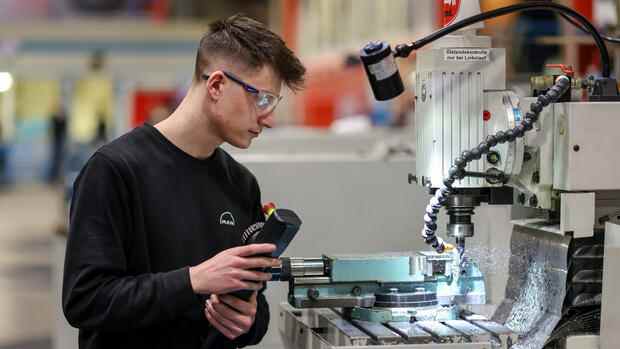The traffic light promises a training guarantee in the coalition agreement.
(Photo: picture alliance / Rupert Oberhäuser)
Berlin The situation on the training market is dramatic: On the one hand, 230,000 vacant training places were still registered with the Federal Agency at the end of July. At the same time, there were still almost 120,000 unplaced applicants across Germany. The difference is bigger than ever.
This brings the “training guarantee” announced by the traffic light into focus. It should “enable all young people access to fully qualifying vocational training, always primarily in the company,” says the coalition agreement – and thus also alleviate the shortage of skilled workers, which, according to Ifo surveys, reached an all-time high in July.
A concept by the Bertelsmann Foundation, which is available to the Handelsblatt, shows how such a guarantee can work. The training guarantee in Austria could serve as a model, said the author, Clemens Wieland, to the Handelsblatt.
In Austria, eight percent of apprentices are now learning in state administration, the vast majority of them in Vienna, where there are very few in-company apprenticeships. The “training guarantee” applies there to all unskilled workers up to the age of 25.
Top jobs of the day
Find the best jobs now and
be notified by email.
In Germany, too, such training, which is guaranteed and financed by the state, must apply to everyone who cannot find a training position, Wieland demands. Nor should it be limited to regions with particularly few training places, as the coalition agreement suggests. “Because even in boom regions there are applicants who get nothing and who need a chance,” said Wieland.
The social partners must be involved from the start. The effectiveness of the guarantee “stands and falls with its acceptance by the economy,” warns Wieland. Without these there would be no cooperation partners and no companies that would take the apprentices out of the state system as soon as possible.
Together with employers and trade unions, the professions in which there are job opportunities must also be determined. Above all, however, it must be prevented that trainees “prefer a state-financed training place despite suitable regular offers”.
Therefore, young people should only get a chance “if all reasonable application efforts have been unsuccessful”. They should prove this with a minimum number of letters of application or rejections received.
State apprentices should receive less tuition
In order to prevent state training from being more attractive than regular training, the training allowances must definitely be lower than in the private sector, says Wieland.
The Bertelsmann expert considers the danger that companies could withdraw from training if the state takes on this task to be low. Even today, a company only provides training, at least in theory, if it ultimately benefits from it. The operational cost-benefit calculation does not change even if the state organizes a kind of second training market. According to studies by the Federal Institute for Vocational Training (BIBB), around 28 percent of trainees already generate net income during their training period.
If, on the other hand, the training is not worthwhile for the companies or only if they later take on the apprentices, the companies would theoretically opt for workers trained by other companies even in a purely company-based training system, explained Wieland. Currently, only 19.4 percent of all companies provide training; in 2007, according to BIBB data, it was still a good 24 percent.
For the state guarantee, young people should have to prove that they could not get a regular training place.
(Photo: dpa)
The state training should be limited to one year of training if possible, also to make it clear that it should only be a bridge to the business world. It may only be extended if, despite massive placement efforts, no company can be found that will take on the apprentice.
Hundreds of thousands stuck in transitional system
It is imperative that when you move to a company, the state part is taken into account. Otherwise there is no difference between state training and the existing transitional system. Vocational schools offer years of basic vocational training or courses in which the participants can catch up on a school-leaving certificate.
>>Read here: More and more young people are getting bogged down in unskilled jobs – but tens of thousands of apprenticeships remain vacant
Critics repeatedly describe this system as a “waiting loop”, also because its measures cannot be counted towards dual training. According to the BIBB, there were still 228,000 young people in this transition area in 2021. For comparison: In the same year, 473,000 young people began an apprenticeship.
According to Wieland, it can be quite attractive for companies to take on trainees from the state apprenticeship. Finally, the companies received “balready pre-qualified trainees, whom you can also get to know beforehand during internships”.
In order to prevent the commissioned training providers from having an incentive to keep young people in their system for as long as possible, training expert Wieland believes that they should receive bonuses for placing them with companies. Wieland promises that the costs will be at least partially compensated for by measures of the transitional system that have become superfluous, “and the state will benefit in the medium term from increasing income due to higher added value”.
More: New high: Every second company complains about a shortage of skilled workers. One industry is particularly burdened by the lack of staff

